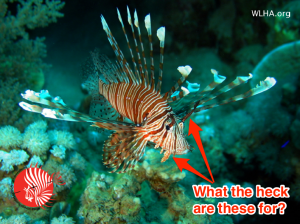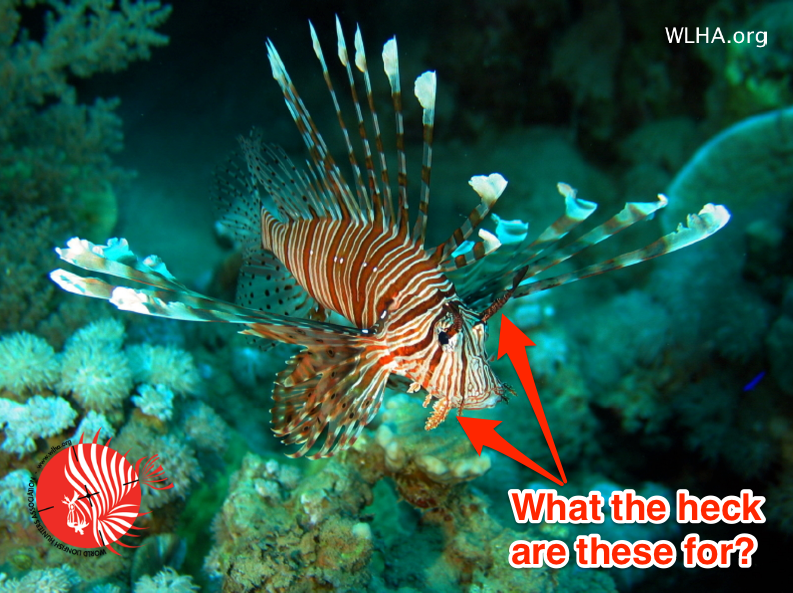1. Where do the names “Pterios volitans” and “Pterois miles” come from? Are lionfish known by other names?
Pterois volitans, which makes up approximately 93% of the invasive lionfish population, is also commonly called “red lionfish” and Pterois miles is often called the “common lionfish” or “devil firefish.” However, their common names do not match the origins of their scientific names.
The genus name, Pterois, pronounced (tare-oh-eese) is defined in modern dictionaries as simply “l ionfish,” however the word Pterois comes from the Greek word “pteroeis” meaning “feathered” or “winged” and the Ancient Greek word, “πτερόν” (pteron), meaning “feather” or “wing.”
ionfish,” however the word Pterois comes from the Greek word “pteroeis” meaning “feathered” or “winged” and the Ancient Greek word, “πτερόν” (pteron), meaning “feather” or “wing.”
The species name, volitans, pronounced (vole-ee-tahnz), is Latin for “flying” or “hovering” and the present participle of the Latin word “volitō,” which means “to fly” or “to hover.”
The species name, miles, pronounced (mee-layz), is Latin for “soldiering” and the present participle of the Latin word “mīlitō,” which means “to soldier.”
You can read our article on how to tell the Pterois Volitans from the Pterois Miles here.
No one is quite sure where the name “lionfish” really came from but it would be a logical guess that when both pectoral fins are completely extended and fanned out a head-on view of the lionfish might resemble a male lion’s mane. Others have also suggested that it might be a tip of the hat to the lionfish as a ferocious predator.
In areas where lionfish are not native, they may also be known by other names such as butterfly cod, firefish, turkeyfish, dragon fish, zebrafish, pez diablo (Spanish for devil fish), pez león (Spanish for “lion fish”), korall duivel (Dutch for “coral devil”), peixe-leão (Portuguese for “lion fish”) and poisson lion (French for “lion fish”).
2. What are the fleshy tentacles above the eyes and below the mouths on young lionfish? What happens to them as they grow older?
 Lionfish have “wigglers” and fleshy nobs over its eyes and under its mouth when they are young. Smaller prey fish are lured to these tassels. When the fish attempt to take the bait, the lionfish is able to swallow them in a lightning fast strike; the hunter becomes the prey! As the lionfish grows older they no longer need these lures as they gain hunting experience. The nobs may eventually be nibbled down to nothing or they can get knocked off as the lionfish moves around its habitat.
Lionfish have “wigglers” and fleshy nobs over its eyes and under its mouth when they are young. Smaller prey fish are lured to these tassels. When the fish attempt to take the bait, the lionfish is able to swallow them in a lightning fast strike; the hunter becomes the prey! As the lionfish grows older they no longer need these lures as they gain hunting experience. The nobs may eventually be nibbled down to nothing or they can get knocked off as the lionfish moves around its habitat.
3. How deep have invasive lionfish been found?
Lionfish have been visually confirmed at a depth of 1000 feet (305 meters) near Lyford Cay, Bahamas.
4. How long can a lionfish survive without eating?
When food is scarce, a lionfish’s metabolism can essentially crawl to a stop; Lad Akins, Director of Special Projects at REEF, said in one presentation not long ago that studies have shown that lionfish can live without food for up to 3 months and only lose 10% of their body mass.
It doesn’t look like we’re going to be able to starve them to death…
On the other hand, a different observation by James Morris, the National Oceanic and Atmospheric Administration’s pre-eminent scientist studying the invasion of lionfish into U.S. coastal waters, uncovered evidence that lionfish might be quite literally eating themselves to death. Obese lionfish are being found with internal organs completed encased in fat. In fact, these lionfish are so fat that they are suffering from liver damage!
Obese Lionfish Source: Slate
5. Are lionfish invasive in other parts of the world other than in the Western Atlantic Basin?
Yes. Lionfish, mostly Pterois miles, are being sighted in the Mediterranean Sea now. They appear to have either transited the Suez Canal from the Red Sea, where lionfish are considered a native species, or private aquarium releases are contributing to their establishment of a new non-native habitat.
Source: Green Prophet
6. Can the invasive lionfish live in fresh water?
No, not exactly. However, in Florida, they are increasingly being found in brackish, esturine environments over 4 miles inland away from the ocean where water salinity is approximately only 6 parts per thousand compared to an ocean average of 33 parts per thousand.
That’s not quite fresh water but it is scary close!
Source: Zac Jud research
7. Is eating lionfish healthy?
 Yes, in fact eating lionfish is healthier than eating snapper or grouper because lionfish have higher concentration of heart healthy omega-3 fatty acids, scoring above snapper and grouper as well as tilapia, Bluefin tuna, mahi mahi, wahoo and other table-fish commonly served in restaurants. Lionfish are also very low in heavy metals like mercury and lead!
Yes, in fact eating lionfish is healthier than eating snapper or grouper because lionfish have higher concentration of heart healthy omega-3 fatty acids, scoring above snapper and grouper as well as tilapia, Bluefin tuna, mahi mahi, wahoo and other table-fish commonly served in restaurants. Lionfish are also very low in heavy metals like mercury and lead!
Nutrition Information Source: BIOFLUX
For more interesting facts about invasive lionfish, be sure to check out our Frequently Asked Questions About Lionfish page!
Do you have any interesting facts about the invasive lionfish that you would like to share? Leave them in the comments below!







Very interesting story send more info if possible
My husband dove with UNEXSO on grand bahama island. He was shocked at the dearth of reef fish, surprised at the abundance of lionfish, as they are unusual to see in hawaii where he most often dives. No mention was made on his excursion about the lionfish problem. Only afterwards did we start googling about the reef fish and learned of it. So sad.
I saw a lionfish when I was diving it. when I was trying to take the picture it bite me. but I am all good it was extremely painful
lionefish are not poisonious they don’t like their pictures taken. nice fish but you must say please. then maybe if they are in a good mood. just like people. how could anyone even think of starving an animal to death. an extermination because? the most poisonis fish in the sea is probably the answer to how we can survive the toxic world. don’t kill them all too soon please?
What the hell are you talking about?
yeah! Ilove lion fish! I get that they are invasive and taking over the world but lets lot eliminate it’s entire existance! (Doing things as crazy a starving it to death is just gonna make it adapt to even longer periods of time over generations to need even less food for longer time). they are saiid to be toxic (they are) but the toxic is only made on physical contact right? so they are not polluting the seas or any of that stuff. I understand that we need to eliminate them or somehow slow down they’re reproduction rate, but you should be more careful about taking them out because they could learn over time all live down to 1000ft like onw was recently spotted
Where is the idea of starving them coming from? You two both sound like morons.
QUESTION 4 IS TIPPING THEM OFF. THE STUDY STATED THAT THE LIONFISH CAN LIVE 3 MONTHS WITHOUT FOOD AND SOMEHOW THAT TURNED INTO WE ARE GONNA STARVE THE LIONFISH TO RID THEM ON EARTH!!
I now know that people like too kill lionfish!!!!
????????
But do you know why? Killing them is not the sad part.
They are an invasive s[species and will kill the environment leading to the death of themselves. We are saving the ecosystem. If you want to see them got to the Red Sea or something.
wow so cool
Are lion fish susceptible to Ciguatera? If so, how common is it?
Yes, they are susceptible to ciguatera but because they eat mostly small juvenile fish and shrimp they do not normally accumulate a lot of the toxin. We’ve still never heard of a person getting sick from eating lionfish, but test have shown they can carry some of the toxin in areas that have very high levels of ciguatera such as St. Maarten and certain areas of the Virgin Islands.
They are an invasive s[species and will kill the environment leading to the death of themselves. We are saving the ecosystem. If you want to see them got to the Red Sea or something.
How were lionfish named lionfish?
Hi, thanks for the question, it is answered in this article. https://lionfish.co/lionfish-called-lionfish/